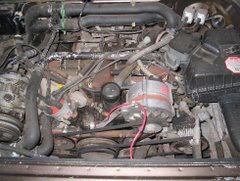All of my Vanagons were wonderful fun to drive. All of them needed constant repair and were astoundingly expensive to fix. Die Sprite had been the oldest and least reliable of all. My husband put his foot down: "We aren't going to replace the engine! No more Vanagons! This time I mean it!" "I just had $1500 worth of brake-work done on it," I wailed. But he was adamant.
I sulked. I announced that if I couldn't have a Vanagon, the only car I wanted was a brand-new

 Toyota Highlander Hybrid. We could have bought three late-model Vanagons for the same price, but even that did not shake Matt's resolve. He was really tired of paying to fix my vans. Although the hybrid Highlander is of course not nearly as efficient as the Prius, I needed seven seats, and I felt good about our decision to get the most efficient seven-seater vehicle available.
Toyota Highlander Hybrid. We could have bought three late-model Vanagons for the same price, but even that did not shake Matt's resolve. He was really tired of paying to fix my vans. Although the hybrid Highlander is of course not nearly as efficient as the Prius, I needed seven seats, and I felt good about our decision to get the most efficient seven-seater vehicle available.But why couldn't we have a fully-electric vehicle as our second car? Our daily commute is 30 miles round trip, well within the range of contemporary battery technology. We began to talk about converting the Vanagon, but there were a few hurdles to overcome, like the fact that we don't have any automotive skills, nor a garage. When I saw an advertisement in Friends Journal for an already-converted electric vehicle, we jumped at the chance to buy it.
 This EV is a 1991 Dodge Colt converted when brand-new by a fledgling EV conversion business in Florida. It belonged to Quaker environmentalists Anne and Tom Moore, passed from them to their nephew, and came to us in need of some reviving. Even with new batteries and charger, though, its 96V system does not give us 30 worry-free miles per charge. It isn't good for lead-acid batteries to be deeply discharged every time they're used. We needed a more powerful EV: an E-Vanagon.
This EV is a 1991 Dodge Colt converted when brand-new by a fledgling EV conversion business in Florida. It belonged to Quaker environmentalists Anne and Tom Moore, passed from them to their nephew, and came to us in need of some reviving. Even with new batteries and charger, though, its 96V system does not give us 30 worry-free miles per charge. It isn't good for lead-acid batteries to be deeply discharged every time they're used. We needed a more powerful EV: an E-Vanagon.to be continued ...





No comments:
Post a Comment